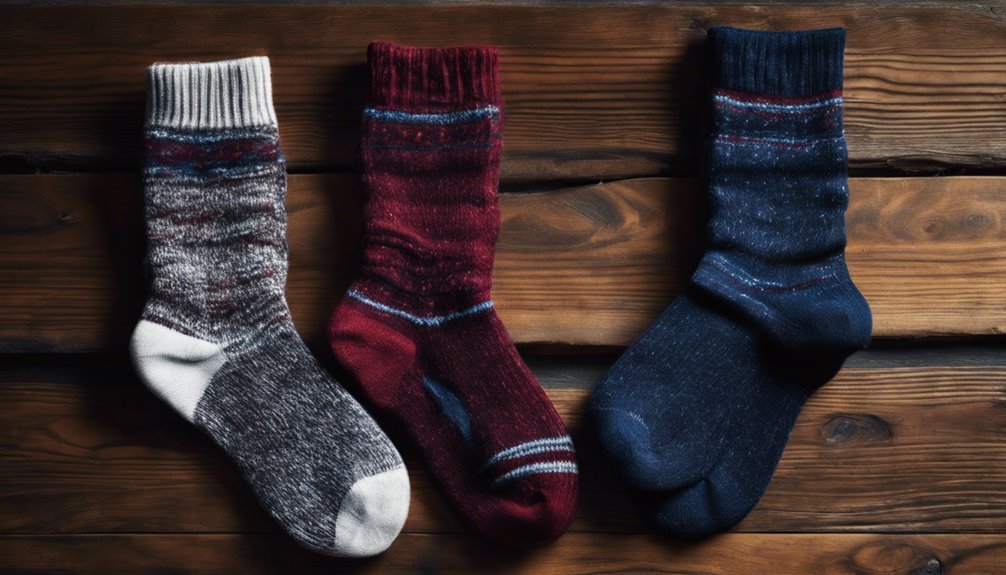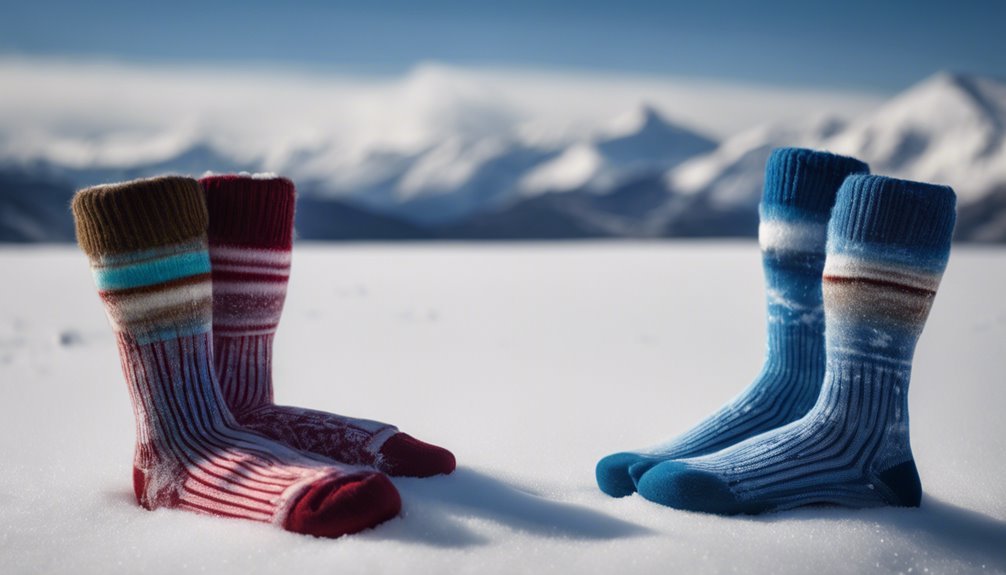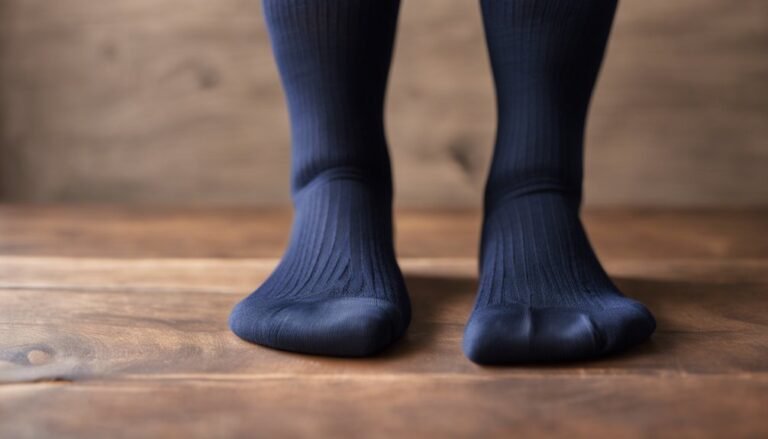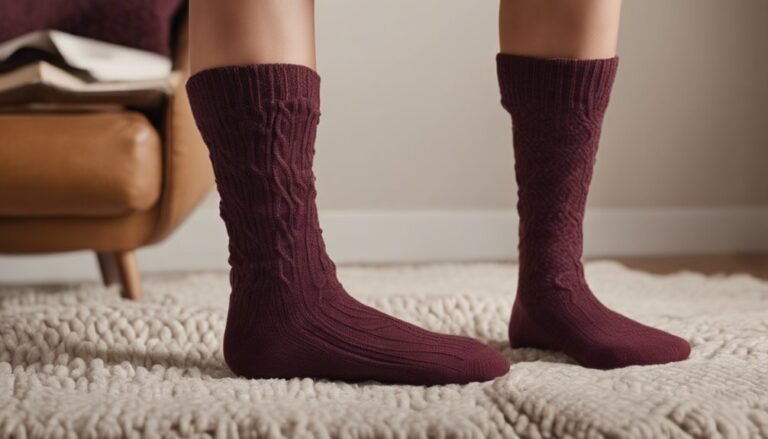Insulated Socks vs. Heated Socks: Which Provides More Warmth?
When deciding between insulated socks and heated socks, consider your specific needs. Insulated socks use materials like wool to trap heat naturally, providing reliable thermal regulation. Heated socks, on the other hand, utilize battery-powered heating elements for customizable warmth but may lose effectiveness in extreme cold. If you're gearing up for everyday winter activities, insulated socks are ideal. For extreme conditions or poor circulation, heated options excel. Discover how each type stacks up in various scenarios.
Understanding Insulated Socks

When it comes to keeping your feet warm in cold conditions, understanding insulated socks is essential. These socks utilize various insulated sock materials, like wool, synthetic blends, and fleece, to trap heat and wick moisture away from your skin. When selecting your socks, consider layering techniques—wearing a thin moisture-wicking sock underneath a thicker insulating sock can enhance warmth without sacrificing comfort. This combination helps maintain ideal temperature regulation while preventing blisters. Look for features like reinforced heels and toes for added durability, especially if you're active outdoors. Remember, the right pair of insulated socks can provide the freedom to explore frigid environments without compromising warmth or comfort. Choose wisely, and your feet will thank you!
The Technology Behind Heated Socks
Insulated socks provide a solid foundation for warmth, but heated socks take foot comfort to another level through innovative technology. These socks typically integrate heat sources, like carbon fiber heating elements, that distribute warmth evenly across your feet. With adjustable settings, you can tailor the heat intensity to your liking, ensuring ideal comfort during cold adventures.
Most heated socks operate on rechargeable batteries, offering varying battery life depending on the heat setting used. Some models can last up to 8 hours on a low setting, providing ample warmth for extended outdoor activities. The combination of effective insulation and advanced heating technology allows you to embrace the freedom of exploring winter landscapes without sacrificing comfort.
Pros and Cons of Insulated Socks
When considering insulated socks, you'll notice their material and design are crafted to trap warmth and wick moisture, making them a solid choice for chilly conditions. However, they can struggle to provide adequate warmth in extreme cold, leaving your feet vulnerable if you're in harsh environments. Understanding these pros and cons will help you decide if insulated socks are right for your needs.
Material and Design Benefits
Choosing the right socks for cold conditions is essential, and insulated socks offer unique material and design benefits that set them apart from other options. These socks typically use advanced material types like merino wool, synthetic blends, and fleece, all designed to trap heat while wicking moisture. Their design features enhance comfort and performance, providing you with freedom of movement.
Here are three key benefits:
- Thermal Regulation: Insulated materials retain warmth without overheating.
- Moisture Management: Wicking properties keep your feet dry and comfortable.
- Durability: High-quality fabrics resist wear and tear, ensuring longevity.
Limitations in Extreme Cold
While insulated socks provide numerous benefits in cold conditions, they do come with limitations when faced with extreme temperatures. In frigid weather, the insulation limits of these socks can be a concern. They're designed to trap heat, but once the temperature dips too low, their effectiveness diminishes. You might find that your feet still feel cold, especially if moisture builds up inside the sock. Additionally, bulky insulation can restrict movement, which isn't ideal for outdoor activities. If you're planning to brave severe cold, consider supplementing your insulated socks with heated options. This combination can enhance warmth and comfort, allowing you the freedom to enjoy your adventures without cold feet holding you back.
Advantages and Disadvantages of Heated Socks
Although heated socks offer a modern solution to cold feet, they come with both advantages and disadvantages that you should consider.
Heated sock advantages:
- Consistent warmth: They provide adjustable heat settings, allowing you to customize comfort.
- Battery-powered: These socks often come with rechargeable batteries, giving you freedom from bulky heating packs.
- Versatile use: Ideal for various activities like skiing or hiking, helping keep your feet cozy in cold conditions.
Heated sock disadvantages:
- Limited battery life: Depending on the setting, they may not last as long as you'd like.
- Weight and bulk: The added technology can make them heavier compared to traditional socks.
- Maintenance: They require careful washing and charging, complicating care.
Comparing Performance in Extreme Cold

When you're facing extreme cold, the insulation efficiency of your socks plays an essential role in keeping your feet warm. You'll want to take into account how well each type retains heat and whether they offer the comfort and flexibility needed for prolonged wear. By comparing these factors, you can make an informed choice that suits your winter activities.
Insulation Efficiency
In extreme cold, the effectiveness of insulation can make a significant difference in your comfort level, and understanding the nuances between insulated socks and heated socks is essential. Insulated socks rely on various insulation materials to minimize thermal conductivity, keeping your feet warm through trapped air and reduced heat loss.
When comparing insulation efficiency, consider:
- Material Type: Wool vs. synthetic fibers can impact warmth and breathability.
- Thickness: Thicker socks can offer better insulation but might restrict circulation if too tight.
- Fit: A snug fit enhances insulation efficiency by reducing air gaps, which can lead to heat loss.
Choosing the right socks based on these factors can help you enjoy freedom in the cold without sacrificing warmth.
Heat Retention Capabilities
While both insulated and heated socks aim to keep your feet warm in extreme cold, their heat retention capabilities differ considerably in performance. Insulated socks excel in heat retention by trapping warm air and minimizing thermal conductivity, effectively preventing heat loss. This makes them ideal for prolonged outdoor activities where you rely on your body heat. On the other hand, heated socks actively generate warmth through built-in batteries, but their effectiveness can wane in extremely low temperatures or if the battery runs low. While heated socks can provide immediate warmth, they may not maintain that heat as reliably as high-quality insulated options. Therefore, choosing between them depends on your needs for sustained warmth versus immediate heat in harsh conditions.
Comfort and Flexibility
Choosing the right socks for extreme cold isn't just about heat retention; comfort and flexibility play a significant role in performance. You need socks that not only keep your feet warm but also allow for movement and breathability. Here's what to take into account:
- Flexible Fit: Look for materials that adapt to your foot shape, providing a snug yet comfortable fit.
- Comfort Levels: Prioritize socks with cushioning and moisture-wicking properties to enhance overall comfort and prevent blisters.
- Layering Compatibility: Choose socks that can be worn with other layers without feeling too bulky.
Factors to Consider When Choosing Between the Two
When deciding between insulated socks and heated socks, it is crucial to reflect on several factors that can impact your comfort and warmth in cold conditions. First, consider sock thickness; thicker socks generally provide better insulation but may reduce breathability. If you're active, that could lead to moisture buildup and discomfort. Next, think about temperature regulation. Heated socks offer customizable warmth but rely on batteries, which can be a hassle. Evaluate your activity level, duration of use, and the climate you'll encounter. If you prioritize freedom of movement, insulated socks might be favorable. Alternatively, if you're stationary in extreme cold, heated socks could be the better choice. Balancing these factors will help you make the right decision for your needs.
Frequently Asked Questions
Can I Wash Insulated or Heated Socks in a Machine?
You can wash insulated or heated socks in a machine, but check the care instructions first. Use a gentle cycle and cold water for best results. Follow these washing tips to maintain their performance and longevity.
How Long Do Heated Socks Typically Last on a Single Charge?
Ever wondered how long you can enjoy the cozy warmth of heated socks? Typically, they last around 6 to 8 hours on a single charge. To maximize battery life, follow usage tips like using lower heat settings.
Are There Specific Materials Best for Insulated Socks?
When choosing insulated socks, you'll want materials like merino wool for its natural warmth and moisture-wicking properties, along with synthetic fibers for durability and quick drying. These combinations guarantee ideal comfort during your adventures.
Can Heated Socks Cause Overheating or Discomfort?
Imagine a cozy fire, but too close, and you risk burns. Heated socks can bring warmth, yet overheating risks and discomfort factors lurk. Adjust settings wisely to enjoy comfort without sacrificing your freedom to move.
What Activities Are Best Suited for Insulated Versus Heated Socks?
For outdoor adventures in extreme cold, heated socks excel, keeping your feet warm during prolonged exposure. For indoor activities like lounging or casual wear, insulated socks offer comfort and warmth without the need for battery power.







